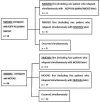Clinical Characteristics of Anti- N-Methyl-d-Aspartate Receptor Encephalitis Overlapping with Demyelinating Diseases: A Review
- PMID: 35837405
- PMCID: PMC9273846
- DOI: 10.3389/fimmu.2022.857443
Clinical Characteristics of Anti- N-Methyl-d-Aspartate Receptor Encephalitis Overlapping with Demyelinating Diseases: A Review
Abstract
Anti-N-methyl-d-aspartate receptor encephalitis (NMDARe), a common autoimmune encephalitis, can be accompanied by demyelinating disorders, including multiple sclerosis (MS), neuromyelitis optica spectrum disorder (NMOSD), and myelin oligodendrocyte glycoprotein antibody-associated disease (MOGAD). To compare the clinical characteristics of patients with different overlapping syndromes, we searched the PubMed database and performed a systematic review. Of the 79 patients with overlapping syndromes, 15 had MS, 18 had aquaporin-4-antibody-positive NMOSD (AQP4-Ab-positive NMOSD), and 46 had MOGAD. Compared with classical NMDARe, overlapping syndromes showed atypical symptoms, such as limb weakness, sensory disturbance, and visual impairments in addition to the main symptoms of NMDARe and a lower ratio of ovarian teratoma. Patients with MOGAD overlap were the youngest, while patients with MS and AQP4-Ab-positive NMOSD overlap tended to be older than patients with classical NMDARe. A majority of patients with NMDARe who overlapped with MS or AQP4-Ab-positive NMOSD were female, but this was not the case for patients overlapped with MOGAD. When NMDARe and demyelinating diseases occurred sequentially, the interval was the longest in patients with NMDARe overlapped with MS. A favorable outcome was observed in patients overlapping with MOGAD, but no robust comparison can be drawn with the patients overlapping with AQP4-Ab-positive NMOSD and MS regarding the small number of available data. The long-term prognosis of overlapping syndromes needs further investigation.
Keywords: aquaporin-4-antibody-positive neuromyelitis optica spectrum disorder; demyelinating diseases anti-N-methyl-D-aspartate receptor encephalitis; multiple sclerosis; myelin oligodendrocyte glycoprotein antibody-associated disease; overlapping syndromes.
Copyright © 2022 Zhang, Yang, Liu, Li, Li and Zhou.
Conflict of interest statement
The authors declare that the research was conducted in the absence of any commercial or financial relationships that could be construed as a potential conflict of interest.
Figures




Similar articles
-
A systematic literature review to examine the considerations around pregnancy in women of child-bearing age with myelin oligodendrocyte glycoprotein antibody-associated disease (MOGAD) or aquaporin 4 neuromyelitis optica spectrum disorder (AQP4+ NMOSD).Mult Scler Relat Disord. 2023 Jul;75:104760. doi: 10.1016/j.msard.2023.104760. Epub 2023 May 11. Mult Scler Relat Disord. 2023. PMID: 37224631
-
Comparison of myelin oligodendrocyte glycoprotein (MOG)-antibody disease and AQP4-IgG-positive neuromyelitis optica spectrum disorder (NMOSD) when they co-exist with anti-NMDA (N-methyl-D-aspartate) receptor encephalitis.Mult Scler Relat Disord. 2018 Feb;20:144-152. doi: 10.1016/j.msard.2018.01.007. Epub 2018 Jan 31. Mult Scler Relat Disord. 2018. PMID: 29414288 Review.
-
The impact of autoimmune comorbidities on the onset attack recovery in adults with AQP4-NMOSD and MOGAD.J Neurol. 2025 Jun 10;272(7):453. doi: 10.1007/s00415-025-13180-3. J Neurol. 2025. PMID: 40495001 Free PMC article.
-
Cerebrospinal 14-3-3 Protein Levels as a Neuroaxonal Biomarker in Aquaporin-4 Antibody-Positive Neuromyelitis Optica Spectrum Disorder.Neurol Neuroimmunol Neuroinflamm. 2025 Sep;12(5):e200432. doi: 10.1212/NXI.0000000000200432. Epub 2025 Jun 30. Neurol Neuroimmunol Neuroinflamm. 2025. PMID: 40587836 Free PMC article.
-
The spectrum of overlapping anti-NMDAR encephalitis and demyelinating syndromes: a systematic review of presentation, diagnosis, management, and outcomes.Ann Med. 2025 Dec;57(1):2517813. doi: 10.1080/07853890.2025.2517813. Epub 2025 Jul 3. Ann Med. 2025. PMID: 40611612 Free PMC article.
Cited by
-
Abnormal Brain MRI in Anti-NMDA Receptor Encephalitis: Clinical and Prognostic Implications.Neurol Neuroimmunol Neuroinflamm. 2025 May;12(3):e200378. doi: 10.1212/NXI.0000000000200378. Epub 2025 Feb 25. Neurol Neuroimmunol Neuroinflamm. 2025. PMID: 39999393 Free PMC article.
-
Anti-N-Methyl-D-Aspartate Receptor Encephalitis With Diffuse Demyelinating Plaques: A Case Report of an Atypical Presentation.Cureus. 2023 Jul 9;15(7):e41595. doi: 10.7759/cureus.41595. eCollection 2023 Jul. Cureus. 2023. PMID: 37559837 Free PMC article.
-
Efficacy of steroid therapy in the acute stage of anti-NMDAR and anti-MOG antibody overlapping encephalitis: a case report and literature review.Front Immunol. 2024 Jun 4;15:1392992. doi: 10.3389/fimmu.2024.1392992. eCollection 2024. Front Immunol. 2024. PMID: 38895128 Free PMC article. Review.
-
Evolution from viral encephalitis to autoimmune encephalitis to multiple sclerosis: a case report.J Neurol. 2024 Oct;271(10):7035-7038. doi: 10.1007/s00415-024-12659-9. Epub 2024 Aug 31. J Neurol. 2024. PMID: 39217218 Free PMC article.
-
Diagnostic Significance of Paraneoplastic Neuronal Antibodies in Japanese Adults with Autoimmune Encephalitis: A Case Series Study in an Adult Epilepsy Clinic.Clin Pharmacol. 2025 Jun 30;17:155-166. doi: 10.2147/CPAA.S514609. eCollection 2025. Clin Pharmacol. 2025. PMID: 40620335 Free PMC article.
References
-
- Nan D, Zhang Y, Han J, Jin T. Clinical Features and Management of Coexisting Anti-N-Methyl-D-Aspartate Receptor Encephalitis and Myelin Oligodendrocyte Glycoprotein Antibody-Associated Encephalomyelitis: A Case Report and Review of the Literature. Neurol Sci (2021) 42:847–55. doi: 10.1007/s10072-020-04942-0 - DOI - PubMed
-
- Fan S, Xu Y, Ren H, Guan H, Feng F, Gao X, et al. . Comparison of Myelin Oligodendrocyte Glycoprotein (MOG)-Antibody Disease and AQP4-IgG-Positive Neuromyelitis Optica Spectrum Disorder (NMOSD) When They Co-Exist With Anti-NMDA (N-Methyl-D-Aspartate) Receptor Encephalitis. Mult Scler Relat Disord (2018) 20:144–52. doi: 10.1016/j.msard.2018.01.007 - DOI - PubMed
Publication types
MeSH terms
Substances
LinkOut - more resources
Full Text Sources
Medical

